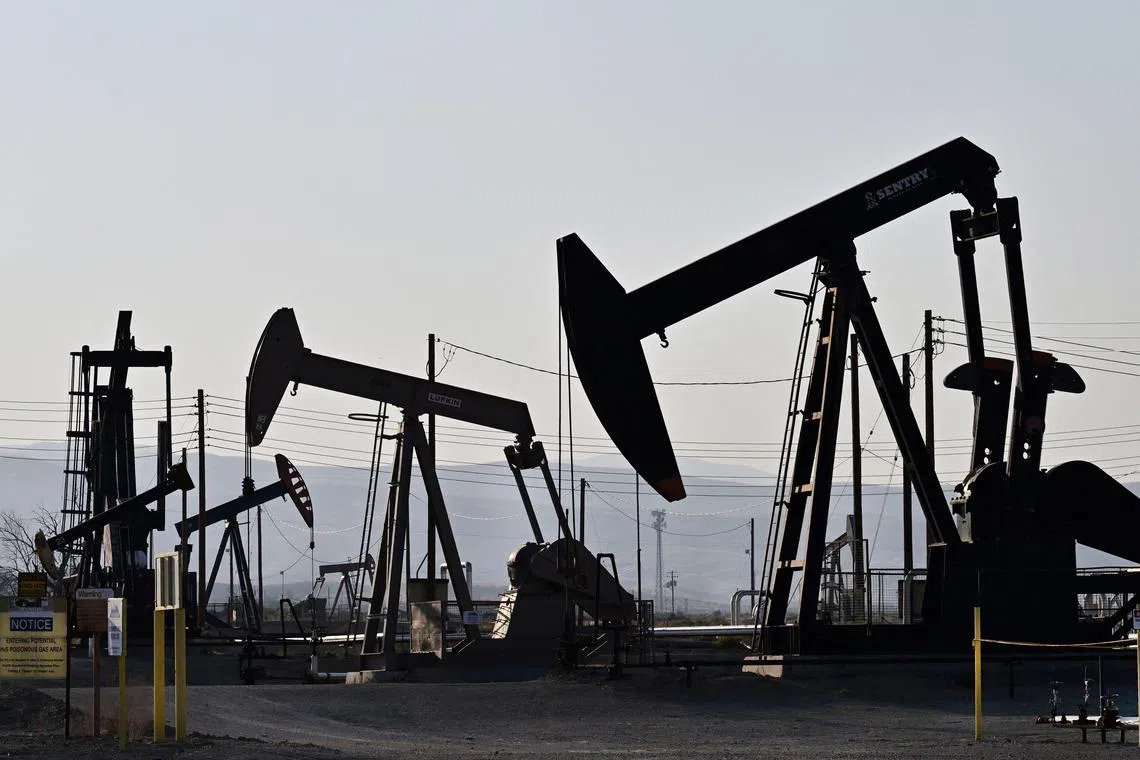Big Oil enters 2024 strengthened by US industry consolidation
Sign up now: Get ST's newsletters delivered to your inbox

The oil and gas industry is taking advantage of high stock prices to secure lower-cost reserves and prepare for more consolidation.
PHOTO: AFP
Follow topic:
HOUSTON - The oil and gas industry went on a US$250 billion (S$330.7 billion) buying spree in 2023, taking advantage of companies’ high stock prices to secure lower-cost reserves and prepare for the next upheaval in an industry likely to undergo more consolidation.
A surge in oil demand has stoked acquirers’ enthusiasm
The grand prize in this dealmaking is the largest shale-oil field in the United States, the Permian Basin in west Texas and New Mexico. The four companies are now positioned to control about 58 per cent of future production there.
Each aims to pump at least one million barrels per day (bpd) from the oilfield, which is expected to produce seven million bpd by the end of 2027.
And more transactions are on the horizon. Three-quarters of energy executives polled in December by the Federal Reserve Bank of Dallas expected more oil deals worth US$50 billion or more to pop up in the next two years.
Endeavor Energy Partners, the largest privately held Permian shale producer, is exploring a sale that could further concentrate US shale oil output.
“Consolidation is actively changing the landscape,” said Mr Ryan Duman, director of Americas upstream research at energy consultancy Wood Mackenzie. “A select few companies will determine whether (production) growth will be strong, more stable or somewhere in between.”
The consolidation will have spillover effects on oilfield servicers and pipeline operators. The companies that provide drilling, hydraulic fracturing and sand and transport oil and gas to market are entering an era of fewer customers wielding more power over pricing.
“Consolidation is good for producers but doesn’t help service companies at all. It will squeeze their margins as existing contracts are renegotiated,” said an executive with a US oil producer who declined to be identified because he was not authorised to speak publicly.
Pipeline operators face their own consolidation wave with fewer new oil and gas pipes being approved and built, said Mr Rob Wilson of pipeline experts East Daley Analytics.
Expansions to existing lines out of the Permian Basin will provide some relief, but by mid-2025 pipeline capacity from the Permian will be 90 per cent full, estimates East Daley.
Hanging on to cash
The latest acquisitions illustrate oil companies’ quest for untapped and lower-cost oil and gas reserves.
Among the major deals of 2023 was Exxon’s US$59.5 billion bid for Pioneer Natural Resources and purchase of Denbury for US$4.9 billion. Chevron offered US$53 billion for Hess and bought oil rival PDC Energy for US$6.2 billion. Occidental will pay US$12 billion for CrownRock.
Helped by their strong share prices, most of the year’s major acquisitions were stock swaps, not the big cash outlays that would jeopardise buyers’ balance sheets if oil prices were to fall as they did in 2016 and 2020. Exxon, for example, is sitting on about US$33 billion in cash, more than six times the amount it held four years ago.
Mr Andre Gan, a partner at Wong & Partners law firm and an M&A expert, said fossil fuels were attracting new investment again.
Rising interest rates in 2023 made paying for acquisitions with stock more attractive to investors than funding new renewable energy projects with cash. Offshore wind projects in the US and France were cancelled due to increasing interest rates and supply chain costs.
Producers have also recognised that the US move towards renewable fuels, electric vehicles and greater energy efficiency will cut fossil fuel consumption and squeeze companies with high production costs.
Oil demand globally rose about 2.3 million barrels per day (mbpd) in each of the last two years, to 101.7 mbpd. That increase tightened global stocks, helping bolster prices as Opec and allies kept output constrained.
Wood Mackenzie expects oil output to rise an average of about 250,000 bpd annually over the next five years, half the level of the prior five years as big oil companies focus on boosting cash flow rather than production. Growing slowly helps companies with untapped reserves control expenses and boost margins.
Consolidation has prompted US antitrust regulators to ask Exxon and Chevron for additional information on their purchases, pushing back deal closings. Both predict they will receive approval, pointing to the size of US oil market and aggressive small rivals as signs that competition will remain robust.
The emergence of fewer, bigger oil producers focused on extending the longevity of their fossil fuel businesses may put the companies in greater tension with governments prioritising a shift to clean energy sources.
Meanwhile, global oil prices are expected to be largely stable in 2024 after averaging about US$83 a barrel in 2023, down from US$99 in 2022. Analysts see oil in 2024 trading between US$70 a barrel and US$90, above the US$64 a barrel average in 2019. REUTERS

